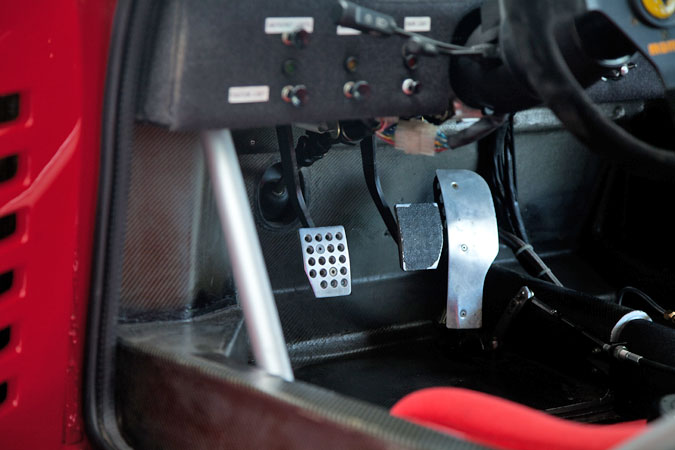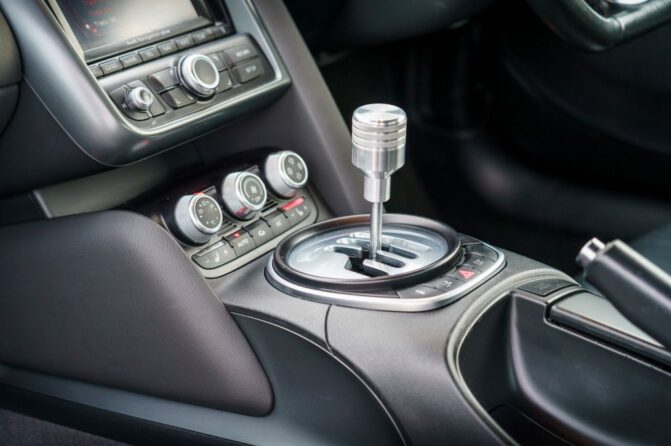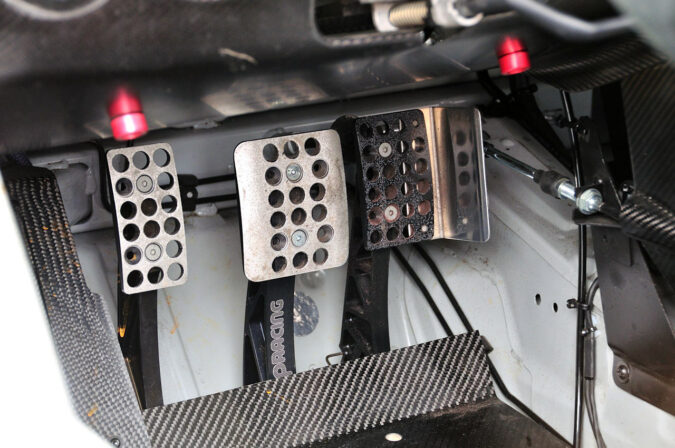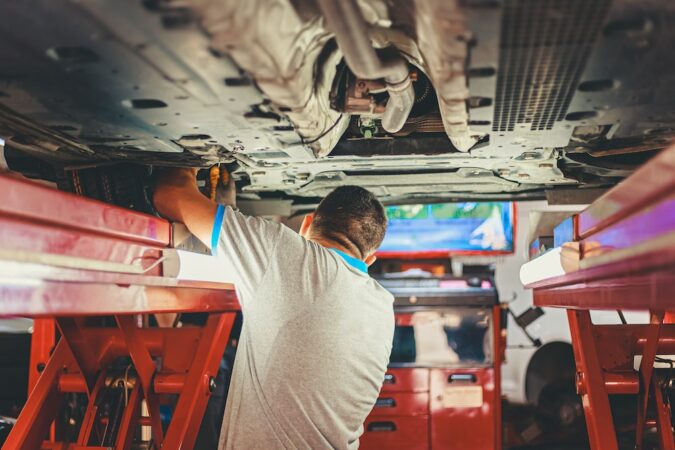The clutch master cylinder is an important part of any vehicle out there and it has a manual transmission. What this does is generate the amount of hydraulic pressure that is required for the clutch to work. The clutch master cylinder is connected to the pedal of the clutch. It relies on the cylinder to cut off the power flow from the transmission to the engine when the pedal is pushed down on.
In simpler words, it separates the engine and the drive wheels so that you can change the gears. If the clutch master cylinder did not create the hydraulic pressure then the clutch wouldn’t be able to do this. When the clutch master cylinder starts to not work the way it should be, a variety of symptoms are seen from the vehicle. It most impacts the ability of your car to change gears.
Most Common Signs Of Your Clutch Master Cylinder Being Bad
You should not be driving in a vehicle that has a bad clutch master cylinder. Doing that will put your life at risk. Not only that, you could put the lives of the passengers in your car and even the people on the road at risk of an accident as well.
We have gathered together some of the most common symptoms that will allow you to understand why your clutch master cylinder has gone bad. Without further ado, let’s jump straight into them!
1. Bad Clutch Master Cylinder Signs: Clutch Fluid Being Low
This is not a prank or a joke, it is real, and clutch fluid is something that is needed in your vehicle. The clutch fluid in the clutch fluid reservoir of your vehicle should be at the same height at all times. Make sure of that when you are looking into the clutch fluid reservoir.
If the clutch fluid is not at the same level as it should be then you most likely have a problem somewhere. The culprit in this situation is most likely to be a clutch master cylinder that is leaking.
You should keep in mind that there are quite a few models of cars nowadays that use brake fluid for their clutch master cylinder. In cars like that, they use a reservoir that is shared. You most likely will not be able to find the reservoir for the clutch master cylinder in them, if that happens then look for the brake fluid.
2. Bad Clutch Master Cylinder Signs: Spongy Or Soft Clutch Pedal
The clutch fluid in your vehicle is just like the brake fluid. What we mean by it is that if it feels soft or spongy, then there is a high chance of your vehicle system having water or air inside of it. You should always keep in mind that having moisture in the hydraulic system of your vehicle is not a good thing.
Since there is already some clutch fluid in the system, there is no one reason for water to be present there. This is why you can tell something is most likely wrong if you feel the clutch pedal in your vehicle is a bit spongy or soft.
The reason behind this would generally be a leak somewhere in the system. Since the problem is with the clutch pedal, the very first thing you should look into is the clutch master cylinder of your vehicle.
3. Bad Clutch Master Cylinder Signs: The Engagement Point Of Your Clutch Is Different
Your clutch is going to be engaging at different points if the clutch fluid in your vehicle is really low. The most common sign of this happening is that your clutch pedal needs to be depressed fully to disengage the clutch. It will be different from the engagement point that you are used to.
Apart from just changing the engagement point of your clutch pedal, it can also do that over a shorter period. What this means is that you might not come up against any problems when you are driving back home from your work, but then when you get into the car the next morning, your vehicle might stall out a few times before you can figure out the problem.
If you do notice something like this happening, then it is definitely in your best interest to take a look into the fluid for your clutch and ensure that there is still enough of it left.
4. Bad Clutch Master Cylinder Signs: Your Clutch Fluid Is Dark After You Change It
It is completely normal for the clutch fluid in your vehicle to break down and wear out. This is why there is nothing to worry about if you have a vehicle that has over 100,000 to 200,000 miles in it and you notice the clutch fluid being a bit dark. Just go right ahead and flush out the fluid and check if that fixes your problem.
However, if you notice the clutch fluid in your vehicle is already going dark just after a few thousand miles, then you might just have an even bigger problem in your hands. When something like this happens, the seals and gasket of your clutch master cylinder are likely breaking down. The contaminants in there are going to be creating a big problem, but you should not ignore the chances of your clutch master cylinder leaking either.
5. Bad Clutch Master Cylinder Signs: Depressing The Clutch Becomes Hard
The whole purpose of the clutch master cylinder in your vehicle is to assist you in disengaging the clutch. This is why it might get somewhat difficult to depress the clutch if the clutch master cylinder in your vehicle is leaking. You should also keep in mind that disengaging the clutch will not at all be possible if the leak is really bad.
6. Bad Clutch Master Cylinder Signs: The Pedal Of the Clutch Is Stuck To The Floor
You can most certainly conclude that the hydraulics in your vehicle system is lost if your clutch pedal is just stuck on to the floor. This is something that is generally seen happening when there is a really big leak in the clutch master cylinder of your vehicle.
When something like that happens to you then you need to get your clutch master cylinder repaired as soon as possible because a stuck clutch pedal will not allow you to shift between gears.
7. Bad Clutch Master Cylinder Signs: The Functions Of A Clutch Master Cylinder
The chamber where your vehicle pushes out the clutch fluid, to help you in disengaging the clutch, is called the clutch master cylinder. One end of the cylinder has something called a pushrod. When you are depressing the clutch, this rod is getting pushed against the clutch fluid.

This in turn pushes it into the slave cylinder and then eventually it goes in the transmission to the clutch fork. The force of the driver pushing down on the clutch pedal is transferred by the clutch master cylinder to the transmission.
8. Bad Clutch Master Cylinder Signs: Location Of The Clutch Master Cylinder
If your knowledge about cars does not expand under the hood of your vehicle, then you are probably wondering where the clutch master cylinder is. Generally, you would find it somewhere around the clutch pedal, but it should be on the other side of the firewall that is in the engine bay. Most of the time you will see that it is located somewhere near the brake master cylinder.
Normally a pushrod is used to connect the clutch master cylinder directly to the clutch pedal. So if you just imagine a line that goes straight from your clutch pedal to the engine bay, you are very likely to stumble on the clutch master cylinder.
9. Bad Clutch Master Cylinder Signs: Squeaking Noises
You will notice the slave cylinder of your vehicle making some squeaky noises often when the clutch is being depressed. This could be something that is caused due to the buildup of rust or some other kind of problem. You might also experience some problems when you are trying to shift gears if the slave cylinder of your vehicle is not working the way it should.
You might notice your vehicle not shifting into gears at all or just automatically shifting into gear even when the clutch is pressed.
10. Bad Clutch Master Cylinder Signs: Slipping
You will find that the speed of the engine is dramatically accelerating if the clutch of your vehicle is slipping a lot. This happens while your vehicle will only increase slightly in speed. The clutch can be caused to slip due to a range of issues. The disc of the clutch could also be going bad.
Open up the hood and check the back of your car engine. You should look out for any type of leaks, especially coolant or oil leaks. If you can find any leaks, then it is most likely the reason that is causing the clutch disc to slip by leaking down on it.
You could also just take a look at the disc itself to check for any type of wear. Just be aware that this is something that you should take your vehicle to a repair shop or a mechanic for unless you are confident in your skills and know your way around the components of a car.
Something that also often causes the clutch disc to slip is when the clutch gets overheated. You can easily make sure if that is the case by letting your vehicle cool off for about an hour and then checking if that stopped the disc from slipping.
11. Bad Clutch Master Cylinder Signs: Noises From The Clutch
When the clutch is depressed and you notice it making a lot of noise, it generally indicates that the pressure of your vehicle is going bad. You will be able to hear a lot of noise and likely feel a lot of vibrations as well if the spring that is in the pressure plate were to somehow break.
It is not possible to just replace the broken clutch disc. So if this happens to your vehicle then the whole clutch would need a replacement. The noise could also indicate that the clutch disc is close to breaking down. The likely reasons could be a worn-out rubber diaphragm or even a broken spring.
Even in that, the clutch would need to be replaced completely. However, if the noise is caused by the bearings inside going bad, then the clutch needs to be completely disassembled and the bearings need to be replaced.
12. Bad Clutch Master Cylinder Signs: Backup Reservoir
If the clutch master cylinder in your vehicle has gone bad then it will cause fluid in the reservoir to rise when you are pressing on the clutch. Should you want to test this and check it out for yourself then you should watch the reservoir and have someone else press on the pedal for the clutch.
If you see that the level of fluid in the reservoir is rising when the clutch pedal is being pressed and then it drops back down when the clutch pedal is being released then it is a very good indication that you might need to replace the master clutch cylinder of your vehicle.
13. Bad Clutch Master Cylinder Signs: Low Levels Of Fluid
If the brake fluid in your system goes down low quite often then it is a good sign that the master clutch cylinder has either already gone bad, is going to be, or is already failing. This is something that is mostly caused due to a leak in the system, however, it might also happen due to some sort of physical damage, such as a leak or a hole.
You might notice that there is fluid out on the ground. See if there’s any fluid leaking out if your vehicle is parked over some absorbent substance, such as dry ground for example. You should regularly monitor the fluid levels if you are suspecting that the clutch master cylinder in your vehicle is going bad or has gone bad already. The cylinder is bad if you notice the fluid having a rapid decrease in level within just 48 hours.
Possible Symptoms
Something you should also check is the fittings and the hoses. This is because the fittings or the hoses might have leaks in them. Look for any type of leakage and the condition of the hose that goes from the brake fluid reservoir to the clutch master cylinder. You should also look out for any leaks around the fittings that surround the master cylinder, and the hose that goes to the slave cylinder from the master cylinder.
Replacement Cost
This is something that entirely depends on the type of vehicle that you have. Depending on the vehicle you are driving, your replacement cost could be quite cheap and even easy enough for you to do it in your garage.
On average the clutch master cylinder replacement cost would get you anywhere from around $200 to even up to $350. However, if your vehicle allows it, then you might be able to do it for just around $60 to about $150 by yourself at home. This can save you a ton of money as well. As long as you do it the right way of course.
To start it off with, you need to buy yourself a new clutch master cylinder. If you go for an aftermarket clutch master cylinder, then you are looking at a price range from $30 to $60. You should keep in mind that going for an OEM part is going to cost you a lot more. This is why if you take your car for repair to a dealership, you have to pay a ton of other additional costs.
Keep in mind that you will also need to replace the clutch fluid of your vehicle. This is something that usually just contains brake fluid. You don’t have to worry about spending a ton on that since it is a relatively small cost and you can easily just factor it in your budget.
Add-In The Labor Cost
Lastly, you will also need to factor in additional costs for labor if you are not going to be doing the repairs by yourself. Even though the clutch master cylinder is generally not in a spot that is hard to get to, the labor costs for this will still usually cost you somewhere around $150 to about $200.
While it is true that doing the repairs by yourself will save you a bit of money, however, it is not something you should do if you are not confident. If you think that you are not tech-savvy enough to handle this by yourself then you should not risk it.
This is because if you don’t know what you are doing, then you can easily allow contaminants such as air to get into the system. This can in turn end up affecting the overall performance of your vehicle.
Keep In Mind
This is something that you should consider doing, replace the clutch slave cylinder in your vehicle at the same time as you are replacing the master cylinder. This is because, usually it is seen that when one of these components fails, the other one follows pretty soon after.
You can also cut some costs by having your clutch master cylinder be rebuilt. Before the installation, most of the units are supposed to be bench-bled. When the clutch master cylinder is done being replaced, the clutch pedal of your vehicle will most likely need some adjustments to be done.
If you are unsure about something then you should take a look into the factory manual of your vehicle to get some additional information. You could also just take your vehicle to a repair shop if you do not feel confident enough.
1. Remove The Clutch Master Cylinder
If you are removing the clutch master cylinder by yourself then you should set aside a container to catch any of the fluid that might come out when you remove the cylinder. You can also use absorbent bags or plastic sheets to protect the paintwork.
2. Unscrewing The Union Nut
Lift the pipe after you unscrew the union nut for the pipe. Make sure that you don’t damage or bend the pipes. To keep the dirt out you can cover the ends of the pipe with a clean plastic bag and secure it with a rubber band.
You then need to have the clutch disconnected from the master cylinder pushrod. You will likely see a clevis pin that is on the pedal arm and it passes through a fork at the pushrod’s end. To release the clevis pin, remove the retaining clip or split pin.
3. Reservoir Cap
You should also remove the cap of the reservoir if it isn’t integral to the cylinder. Use a small sheet of plastic to put on the reservoir’s mouth and then screw on the cap on top of the plastic. Doing this will help you to reduce the amount of fluid lost through the pipe to the cylinder. It does this by blocking out the vent hole in the cap. Now unscrew the union nut that connects the cylinder to the pipe.
Pull off the connecting pipe of the reservoir or the reservoir itself from the cylinder and be quick to plug the hole at the end of the pipe or in the reservoir using a cork or a small rubber bung.
The master cylinder is normally held to the bulkhead with two nuts on studs or just two bolts. You can lift off the cylinder just by unscrewing those. You should try watching a video tutorial online for a better understanding.
Clutch Hydraulic System Troubleshooting and Repair Facts:
- If a hydraulic clutch pedal feels ‘spongy’, it may be due to air in the system.
- Worn or ill-fitting seals in hydraulic cylinders can cause hydraulic fluid to leak past the piston, preventing the clutch from disengaging fully.
- Hydraulic fluid is hygroscopic and can cause corrosion in cylinder bores.
- Service kits with new seals are needed to fix worn or damaged seals.
- Trying to smooth the bore with abrasives can cause roughness and quickly wear out new seals.
- A lack of fluid is easily fixed by topping up the master-cylinder reservoir, but leaks must be identified and repaired.
- Bleeding the clutch can remove air from the system.
- It’s important to use the same manufacturer or an approved successor when replacing a master or slave cylinder.
- The clutch cylinder is usually on the right when the clutch and brake master cylinders are side-by-side.
- To remove the clutch master cylinder, a container to catch fluid is needed, and the pipe should be covered to keep dirt out.
Final Words
The clutch master cylinder is a component of your vehicle that is very important. Not only for your safety but also for the safety of the passengers in your vehicle and the people out on the road. It can also damage your car and leave you with a costly repair job if it is not dealt with as quickly as possible.
We hope that this helped you in learning more about the clutch master cylinder in your manual transmission system. Make sure to get your vehicle checked if you notice any of the symptoms mentioned above and drive safe!



